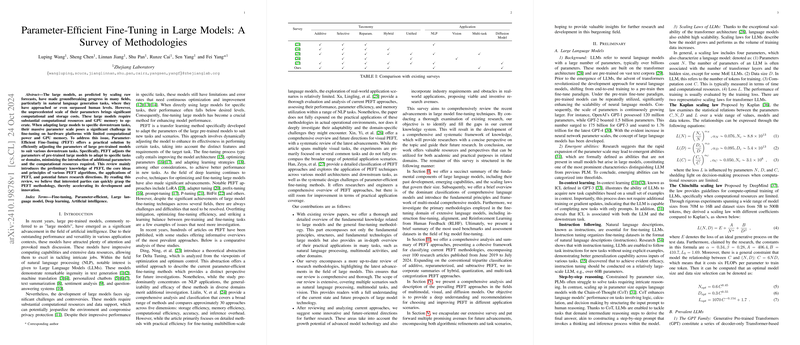An Expert Overview of "Parameter-Efficient Fine-Tuning in Large Models: A Survey of Methodologies"
The paper "Parameter-Efficient Fine-Tuning in Large Models: A Survey of Methodologies" by Wang et al. systematically explores the sophisticated landscape of parameter-efficient fine-tuning (PEFT) methods within the context of LLMs. The immense increase in the scale of model architectures, while yielding a notable enhancement in task performance, has introduced substantial computational and storage burdens due to the vast number of parameters involved. This survey comprehensively explores the mechanisms and strategic innovations designed to mitigate these challenges.
Key Insights into PEFT Techniques
The paper presents an extensive classification and analysis of various PEFT methodologies, categorizing them into several primary classifications: Additive, Reparameterized, Selective, Hybrid, Quantization, and Multi-task PEFT methods. Each class addresses the fine-tuning problem through different paradigms—by either introducing new trainable parameters, restructuring existing model parameters, or efficiently selecting parameters for training.
- Additive PEFT techniques, such as Adapter layers and Soft Prompts, focus on adding extra modules or parameters that are adjusted during the fine-tuning process while keeping the core model parameters fixed. These approaches notably reduce the resource cost with negligible loss in model performance across diverse tasks.
- Reparameterized PEFT endeavors involve techniques like Low-rank Decomposition (exemplified by LoRA), which structurally reorganize model parameters into a more conducive form for efficient adaptation during training.
- Selective PEFT methods refine the focus of tuning efforts by targeting specific subsets of parameters. This strategy aligns well with the principles of sparsity and efficiency in model adaptation.
Comparative Analysis and Implications of PEFT
Through comparing existing surveys, the paper highlights that most prior work has not addressed practical applications across divergent domains comprehensively. By assembling a breadth of techniques and their applications in vision, diffusion, and multimodal models, this work lends significant depth to the academic conversation around adapting large models to constrained computational environments.
The implications of these methodologies resonate strongly in fields where computational resource constraints are critical but high accuracy is necessary, such as healthcare AI, real-time translation services, and edge computing applications. The paper suggests that advances in PEFT not only foster resource-efficient AI solutions but also expand the applicability of AI to real-world problems that necessitate fast, efficient model update capabilities.
Future Directions in PEFT Research
The authors identify promising avenues for PEFT research, such as the exploration of multi-objective learning tasks that address an array of fine-tuning challenges. Furthermore, the paper advocates for the expansion of PEFT techniques into multimodal and continual learning scenarios, which are imperative for advancing AI's capacities to handle dynamically evolving data from multiple input sources.
Concrete algorithmic strategies, like the automated design of adaptable modules (such as adapters and prompts), and enhanced heuristic strategies for hybrid PEFT methods, are underscored as critical areas needing robust exploration. This survey thus calls for greater focus on automated approaches in PEFT configurations that dynamically tailor to both text and multimodal data landscapes.
Conclusion
In summary, the survey presented by Wang et al. contributes a critical academic resource, systematically categorizing and discussing a pivotal aspect of modern AI architectures—Parameter-Efficient Fine-Tuning. It challenges the frontier of AI research by reducing computational barriers and adapts large pre-trained models more effectively across diverse tasks and environments. This resource not only serves as a guiding framework for current AI applications but also as a foundational stepping stone for authors and practitioners aiming to modularize and strategically optimize AI efforts amid the constraints inherent in real-world deployment contexts.
